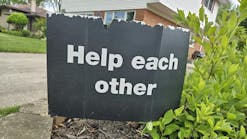Third in an occasional series...
By JAMES P. WALTZ, P.E., C.E.M., DABFET, FCABE
As a member of the HPAC Editorial Advisory Board for over 20 years, and as a fellow and founding chair of the first U.S. chapter of the British Chartered Association of Building Engineers (CABE), it seems appropriate to share some of my experience as a forensic engineer and as an expert witness in nearly 70 cases.
In this case we were brought in by counsel representing one of the defendants named in an HVAC construction defect case regarding the HVAC systems in a brand new county office building. In particular, a thermal energy storage (ice) system had been designed and specified by the engineer of record for the county.
Being a public works project, the county wimped out when the low-bid contractor advised that, to satisfy the county’s intent to award to the low bidder, the low bidder had excluded the heat exchanger that was part of the design to separate the low-temperature fluid in the central plant from the chilled water distributed to various air-handling systems throughout the complex. The specified system was one that employed a brine (salt water) solution as freeze protection in the chilled water system.
- On May 26, the author presents a special HPAC Webinar, Making Buildings Work: Building Pressurization Fundamentals.To learn more and to register, click here.
The upshot is that the corrosion inhibitors in the brine were incorrectly employed and corrosion of the nearly-all-steel piping system proceeded so rapidly that pin-hole leaks developed in the copper tubing in the air-handling unit coils in 90 days following startup of the system. Some of these leaks, incidentally, were in the fan-coil units serving the county’s computer server room! (How would you like salt water spray being applied to your central computer equipment?)
On the way to our first site visit, I asked counsel why they hadn’t already written a check. Counsel’s response was, “Well, you’re not helping very much.” My response was that, indeed, I was helping, as the plaintiff’s building was damaged by one or more of the defendants, and that counsel likely thought that the damages had since been remediated. But the truth was that the defendants had introduced a “cancer” into the HVAC piping, and that ongoing further damage was certainly occurring even as we were driving to the building.
The case then went dormant for about a year and a half – after which I got a call from the new counsel that had taken over the case, explaining to me that proceedings were active again. In the process of assisting with reviewing case documents and assisting counsel during settlement meetings, I finally learned what had transpired.
It seems that the original claim was some $400,000, and the defendants attempted to settle for $250,000. The county supervisors apparently rejected this out of hand, and then went out and hired new experts to represent them. The result was that a year and a half later, the claim was now some $4 million, and any possibility of settling for a measly $400,000 was completely out of the question!
It occurred to me, at this point in my expert witness career, that never advocating, per se, for either side of a case was indeed the ethical and proper behavior of an expert, and that the greatest value I brought to the table was to assist counsel in formulating their approach to their case (if they were not so ego-driven as to reject such a notion).
I consider it a badge of honor that very, very few of my cases have gone to trial, and when they did, my judgment of who was on the “right” side of a case was proven correct in every instance. Wise counsel needs to know when it is time to settle. And a good expert can help them to know that – whether they represent the plaintiff or the defendant.
##########
Based in West Sacramento CA, the author is president of Energy Resource Associates Inc., specializing in turnkey forensic examination and engineering of infrastructure renewal for existing-building mechanical, electrical, control, and structural systems. Waltz is a member of the Association of Energy Engineers Hall of Fame, and a fellow of the first U.S. chapter of the Chartered Association of Building Engineers (CABE – UK), which he chairs. Waltz joined the HPAC Engineering Editorial Advisory Board in 2000. Contact: [email protected]









